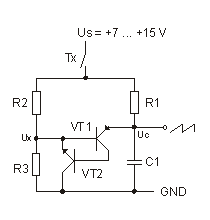I would be grateful for a professional translation or correction of the following text. Please E-Mail to Delta Lima 2 Yankie Echo Oscar @ Queen Romeo Papa 4 Uniform .Delta Echo
Sidetone Oscillator with NE567
Who would like to build a sidetone oscillator with a minimum amount of parts should try the NE567 integrated circuit. The NE567 is a PLL circuit with an internal VCO for a operating frequency less than 500 kHz and it is normally used as an audio tone decoder. The VCO frequency is adjustable by two passive components only. For a 750 Hz sidetone in an amateur radio application the capacitor C1 and the resistor R1 define the VCO frequency. The IC supplier allows for R1 a range of 2 .... 20 kOhm.
Fig. 1: External circuitry
The sidetone can be taken from pin 6 as a symmetrical triangle signal or as a high impedance square wave signal from pin 5. The triangle signal has an amplitude of 1 Vss and the square wave signal of 2 Vss. In order to switch on the oscillator during transmit mode Tx, one can connect pin 7 to Gnd or pin 4 to Vcc. Pins 1, 2, 3 and 8 remain free (nc). The permissible supply voltage Vcc is +4 V to +10 V. With about 6 mA at Vcc = +5 V the IC is relatively economically in its current consumption.
Formula |
fo = 1 / (1,1 * R1 * C1) | |
|---|---|---|
| Units: | fo [Hz], R1 [kOhm], C1 [uF] | |
| Example: | R1 = 12 k | fo = 750 Hz |
| C1 = 0,1 uF | ||
| Us = +5V | ||
If someone finds somewhere a 750 Hz sidetone oscillator with less than three parts, please inform me about this circuit (Hi).
Sidetone Oscillator with 2N3904/3906
The second sidetone oscillator is build up completely discrete with two
transistors and four passive components. The VT1 and VT2 arrangement
corresponds to the thyristor substitute circuit, but with something special.
Not the emitter of VT2 but the VT2 collector is connected to Gnd potential.
If one runs VT2 as usual with the emitter connected to ground, VT1 and VT2
together have a very high current gain. This high gain causes that the low
current flow through R1 (C1 is discharged via VT1) is sufficient high that both
transistors remain in the on state. Hence periodically charging and discharging
the capacitor is impossible, because the hold on current will never be fallen
below. A measure against this effect could be a low impedance voltage divider
R2/R3 in order to take over a partial current (Ic_VT2) or a gain reduction. The
later is achieved very easy with the reverse operation of VT2. The hold on
current is fallen and thus VT1 and VT2 return to the off state after
discharging C1.
Now the circuit operates as planed. C1 will be charged by a low current via R1
up to the voltage rate Uc = Ux + 0,7 V. A small basis current flows
into VT1 as soon as Uc exceeds the limit value Ux + 0,7 V. VT2 conducts too by
the now starting collector current. On the basis of the positive feedback both
transistors are conducting quickly and VT2 discharges the capacitor
immediately. The collector current defined by R1 is lower than the hold on
current required for VT1 and VT2. Both transistors go back to the
non-conducting state and the game starts from the beginning.
Fig.1: Discrete designed oscillator

The advantage of the circuit is the excellent frequency stability a supply voltage changes. If the supply voltage decreases the charging time of C1 rises and thus the frequency. Because the limit value Ux decreases at the same time the frequency rises thereupon. The achievable compensation with the specified components within the voltage range Us = +7 ... +15 V is nearly perfect. The difference to the 650 Hz nominal frequency is only +/- 5 Hz. At 2 V supply voltage the saw tooth signal amplitude at the output is 2,5 Vss. The Tx control signal can not only switch off and on the the complete circuit but it can also supply it due to the low current consumption of less than 0,5 mA. The Us terminal is not necessary then.
| Parts | Value |
|---|---|
| R1 | 120 kOhm |
| R2 | 22 kOhm |
| R3 | 6,8 kOhm |
| C1 | 0,047 uF |
| VT1 | 2N3906 |
| VT2 | 2N3904 |